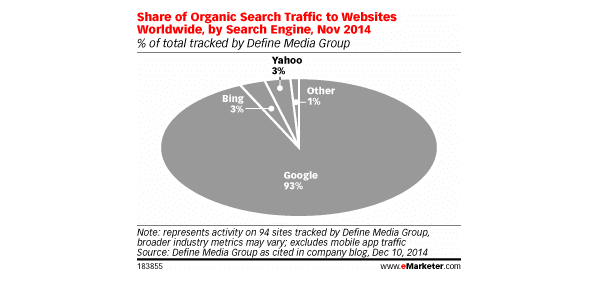Web technology changes rapidly. I mean, let’s face it: the Internet is different today than it was just a few years ago. So when it comes with website optimization, this leaves many people confused as to which SEO strategies are still relevant. Even if you create a compelling, interesting site – employing outdated SEO strategies can affect you negatively.
Below I’ve outlined 8 outdated SEO strategies you need to cut out right away. Using the following methods would result in penalties that can hurt your presence in the SERPs. Thankfully, they’re easy to avoid once you’re aware. Let’s get to it.
1. Stop Ignoring Other Search Engines

Google has the most comprehensive set of resources for SEO. Anyone interested in SEO should definitely get a Google Search Console account, and follow the Google webmaster guidelines for the best practices. But that does not mean you should ignore other search engines like Bing, and Yahoo.
These search engines are still a major source of organic traffic. Additionally, tools such as Bing’s Webmaster Tools can supplement your SEO efforts – giving you more data to work with.
2. Stop Using SEO Data in Your WordPress Themes
This is more of a preference than anything, but I have seen people lose all their SEO data because they used the built-in SEO features. Adding meta descriptions to hundreds of pages because they were all lost in the move doesn’t not sound like fun. It’s a part of best practices to follow the convention to separate presentation from content to avoid this.
Otherwise when you switch themes, you will either:
- Lose all your data
- Or have to migrate everything, which isn’t easy.
[et_bloom_inline optin_id=optin_2]
3. Stop Ignoring Mobile Site Optimization
On January 10, 2017, Google announced that
…pages where content is not easily accessible to a user on the transition from the mobile search results may not rank as high.
Most web designers have noticed the mobile-first trend that took over web design a few years ago. Despite this, a large majority of sites are still not mobile-friendly. Even if the majority of your audience views your content from a desktop computer, you will still miss out on mobile traffic.
What you can do:
- Make sure your text has readable zoom.
- Use a mobile responsive WordPress theme.
- Avoid using Flash or other software that isn’t common on mobile devices.
- Place links far enough apart so they can be tapped easily.
- Read up on Accelerated Mobile Pages (AMP), because it’s becoming increasingly important.
Checkout the Google’s webmaster’s guide on mobile friendly sites for more in-depth information on keeping your site mobile-friendly.
4. Stop Using Intrusive Interstitials for Mobile Traffic
Browsing some sites on a mobile device isn’t always easy. We’ve all been intruded upon by an interstitial at one point or another. Don’t be ashamed, it’s not your fault. In Google lingo, an intrusive interstitial is anything that makes your content less accessible. Whether it’s by design, or by accident, stop using methods that do this on mobile devices. The following images from Google’s webmaster blog show examples of intrusive interstitials.

From left to right: Intrusive pop-up, intrusive standalone interstitial, intrusive standalone interstitial
There are many cases where an interstitial is necessary. The images below show examples of interstitials that are acceptable.

From left to right: interstitial for using cookies, interstitial for age verification, a banner
5. Stop Trying to Rank Multiple Keywords on a Single Page
Targeting keywords is still as important as ever. But trying to target more than one keyword is not as effective as focusing on a single keyword or phrase.
What you can do:
- If you have more than one target keyword you want to focus on, consider breaking your article up into multiple posts.
6. Stop Posting Daily
There’s nothing wrong with posting daily, if you can manage to maintain high-quality posts. In the past, anyone could post poorly curated content to trip the search engines and get better rankings. Nowadays this can actually harm standings with search engines, and your reputation.
While there aren’t many hard, written-down rules when it comes to SEO, we have seen better results from focusing on high-quality content. Fresh content that meets this criteria is great, but it can be equally important to update some of your old content.
What you can do:
- Find one of your pages that is doing well in the search results.
- Add value to the article or post by adding fresh, relevant content.
- Change the publication date.
That not only brings more value to your audience than a hasty post, but it will also rank high in the SERPs. If you are unsure what search engines deem “high-quality,” visit this Google Webmaster blog post to see a laundry list of guidelines and criteria that can help. Joost De Valk also published a helpful article on cleaning up old posts.
7. Stop Submitting Your Site to Search Engines
It’s not hard to submit your site to a search engine, but it’s been practically useless since 2001. Crawlers will be able to find your site. If you’ve made improvements to your website and want that to reflect in the search engine results pages, you can contact Google for reconsideration.
8. Stop Using Outdated SEO Strategies for Linking
The best practice for getting high-quality sites to link back to you is to create relevant content and to network with others who write about the same topic. There’s no shortcut around this. Creating high-quality content will pay off.
Methods of link building like buying backlinks aren’t easy money for SEO companies like it was in 2005. Stop doing these three linking methods:
- Unnatural keyword placement for links. Crawlers are much better at detecting natural language than before.
- Forum comments with optimized links.
- Buying or selling backlinks. This black hat SEO technique can hurt your rankings and it can be difficult to repair.
It’s also important to make sure that anyone you hire for SEO doesn’t use any methods that might result in penalization. Learn more about link schemes so you know what to avoid.
[et_bloom_inline optin_id=optin_2]
Wrapping Up
SEO has come a long way since the late 1990s, back then it things were much simpler. All you needed to do was tag your site with keywords, submit it to a search engine, and a bot would crawl your site. Now the bots are more sophisticated, and many outdated SEO strategies are no longer effective.